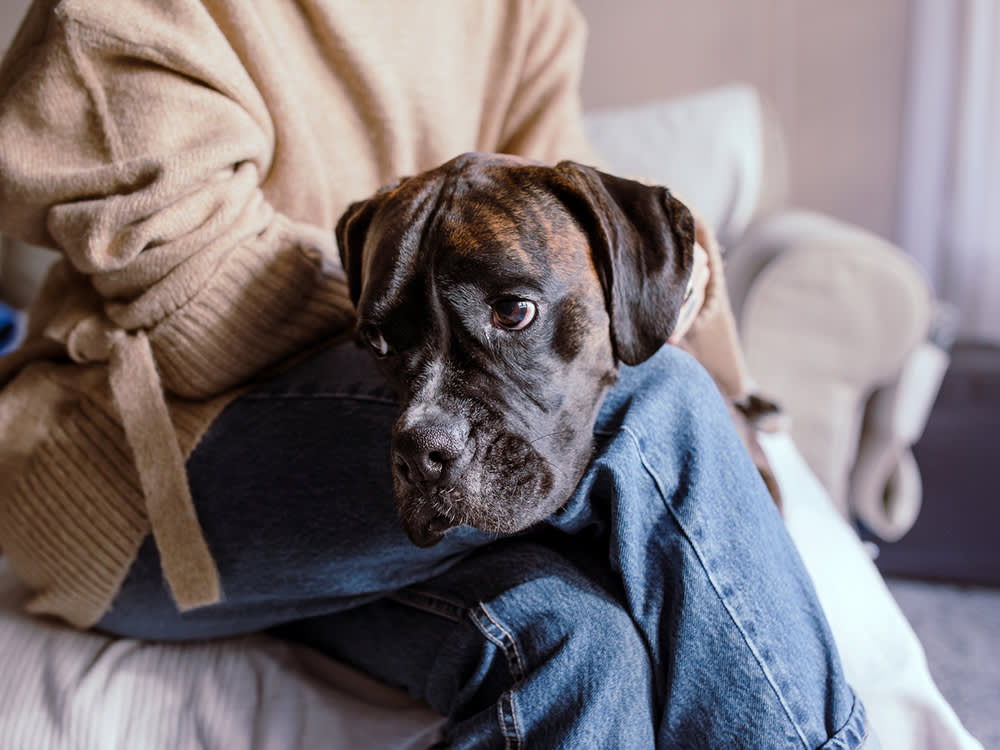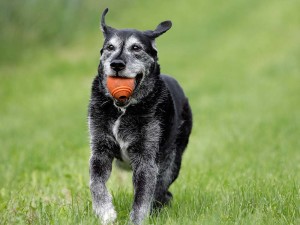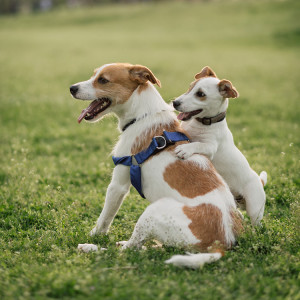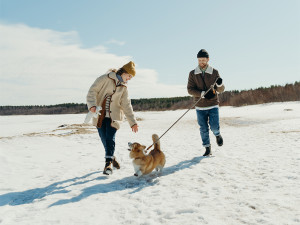Don’t Ignore These 9 Behavioural Signs That Your Dog Is in Pain
Animal behaviourist Karen B London breaks down the silent ways your pet is trying to tell you they’re hurting

Share Article
For the first couple of weeks, our family dog, Bugsy, enjoyed playing with our foster puppy. Then he changed, tiring of her quickly and often avoiding her, even growling if she approached him while he was on his bed. He stopped playing in the snow with her and would go to his bed rather than lie next to her on the rug. We figured that when she left, he would stop being sulky and return to his usual upbeat, playful self.
When Bugsy remained grumpy after the foster puppy left, we suspected that something was wrong. And it was. The veterinarian determined that he had a partial tear in his anterior cruciate ligament, or ACL (a knee ligament) and was probably in considerable pain. The way Bugsy was acting should have told me that he was hurting. Most dogs are not obvious about it, but there are many behavioural signs of pain that you can look out for. If you find that your dog is suddenly avoiding you or other things they previously enjoyed, it’s time to look into what’s going on.

Get (totally free) deals for food, treats, accessories, tech and way more pet parenting must-haves.
opens in a new tabSigns of pain in dogs
1. Changes in behaviour
Any change can mean something is wrong. If your dog is less energetic or less cheerful than usual, doesn’t engage in the activities they usually enjoy, acts restlessopens in a new tab, becomes unusually clingy, or stops socialising as much or as happily as they used to, they may be experiencing discomfort.
2. Nighttime grouchiness
Even minor injuries can be exacerbated by the day’s activities, resulting in a cranky pup in the evening, if they have pushed themselves too hard or done too much.
3. Good days and bad days
If your dog acts like their normal self some days but is grumpy, aggressive, or otherwise different on other days, pain could be to blame.
4. Unusual behaviour after strenuous activity
Dogs who exhibit unexpected behaviour after they have had more exercise than usual may be in pain. An injury or any kind of soreness may become worse with additional exercise, so if your dog is predictably out of sorts on such days, pain may be the culprit.
5. Suddenly behaving aggressively
If a fully mature dog suddenly exhibits aggressive behaviour, it may be because they’re in pain. I’m especially alert to the sudden onset of aggression in a dog over the age of four, because dogs that age with no history of aggression rarely behave this way unless something is wrong.
6. Unwilling to play
If a dog who usually takes any opportunity to play with reckless abandon ceases to be interested in playtime, it could be a sign that something hurts.
7. Avoiding other dogs
Sometimes when dogs are in pain, they don’t want other dogs near them, especially if those dogs are young, bouncy or exuberant. If it is inconsistent with a dog’s personality to shy away from other dogs, doing so might mean they’re protecting an already tender area.
8. Loss of appetite
A dog’s refusal to eatopens in a new tab, which can have many causes, will almost always result in a trip to the vet. Although sometimes the diagnosis is serious – liver failure or cancer, for example – not eating can also be a sign of pain from other less-alarming conditions.
9. Reacting badly to being touched
If your dog reacts negatively to a touch that they would normally like (or not be bothered by), that reaction may be due to pain. Typical negative reactions include yelping, leaping, whining, licking your hand, pulling away or even growling. Most pups will have a pain-based reaction when you touch that specific problem spot, and some will begin reacting to being touched anywhere (or even when you look as if you are going to touch them). This could be because they have learnt to associate these actions with pain
If you have any reason to suspect that your dog may be in pain, make an appointment to see your vet right away, like we did with Bugsy. It was a relief to know exactly what was going on with him and to be able to ease his misery. Only a veterinarian can diagnose a medical condition, but with astute observations of the behavioural warning signs, you can help save your dog from unnecessary suffering if you get help quickly.
To identify an issue with your dog, you must first be able to recognise what is normal for them. You know your pup better than anyone else, and you will have to decide when a situation requires help from your vet. Changes in a dog’s behaviour or body may be subtle, making noticing a problem more difficult. Learn the basics for doing an at-home physical exam of your dogopens in a new tab.

Karen B. London, PhD, CAAB, CPDT-KA
Karen B. London, Ph.D., is a Certified Applied Animal Behaviorist and Certified Professional Dog Trainer who specializes in working with dogs with serious behavioral issues, including aggression, and has also trained other animals including cats, birds, snakes, and insects. She writes the animal column for the Arizona Daily Sun and is an Adjunct Professor in the Department of Biological Sciences at Northern Arizona University. She is the author of six books about training and behavior, including her most recent, Treat Everyone Like a Dog: How a Dog Trainer’s World View Can Improve Your Lifeopens in a new tab.
Related articles
- opens in a new tab
Does Your Dog Think Every Day is Hump Day?
Advice on how to deal with your dog’s humping habit
![A happy looking man and woman walking their dog outside in a large snowy field.]() opens in a new tab
opens in a new tab10 Ways to Make Your Dog’s Life Better
Simple resolutions to boost your dog’s happiness, health and well-being all year long
- opens in a new tab
“How Do I Get My Puppy to Stop Biting My Ankles?”
Dog trainer Robert Haussmann’s tips for dealing with an attention-seeking puppy
![Border Collie digging into a plate of dog food while seated at a yellow table]() opens in a new tab
opens in a new tabHow You Can Easily Manage Your Dog’s Weight
Keep your pup’s weight down, and you could add years to their life. What’s better than that?




